Belarus Interior Ministry exaggerates protester violence to justify excessive force
Two months after contested election, law
Belarus Interior Ministry exaggerates protester violence to justify excessive force

Two months after contested election, law enforcement returns to using disproportionate violence against protesters

Belarus law enforcement bodies are exaggerating the level of protester violence to justify increased police brutality and use of firearms against Belarusians. The escalation in force took place the next day after Belarusian President Alyksandr Lukashenka visited political prisoners to discuss the country’s constitutional reforms. Many political analysts viewed it as the result of increased pressure from Moscow to resolve the political crisis and pressure from the European Union to free political prisoners. The increased police brutality could be a sign of Lukashenka’s impatience to stop the protests before they expand any further.
Protests in Belarus started after the presidential election on August 9, 2020. According to the final election results, Lukashenka received 80.1 percent of the vote to Sviatlana Tsikhanouskaya’s 10.1 percent. The lopsided vote count, public distrust in their veracity, and allegations of electoral fraud led to the ongoing protests around the country. Law enforcement has engaged excessive force by beating, torturing and humiliating detained protesters.
Protesters violence
On October 12, 2020, the Belarusian Ministry of Interior (MoI) announced on its spokeswoman’s Telegram channel that Belarusian law enforcement officers and internal military troops “will not leave the streets and, if necessary, will use special equipment and military weapons.” The post justified such a step with the observation that the protests had become “organized and very radical.” This was in reference to another post published on the spokeswoman’s Telegram channel earlier that day. That post listed incidents of protester violence on October 11. The earlier post also contained a YouTube video that compiled evidence of protester violence. The video has provided justification for increased police brutality since then.
The most violent episodes in the video showed protesters blocking highways, tossing flower boxes, throwing objects at a police minibus, and burning tires.

The popular anti-Lukashenka Telegram channel NEXTA Live did not deny the violence on the streets. It confirmed road blocking and burning of tires “in one of the districts.”
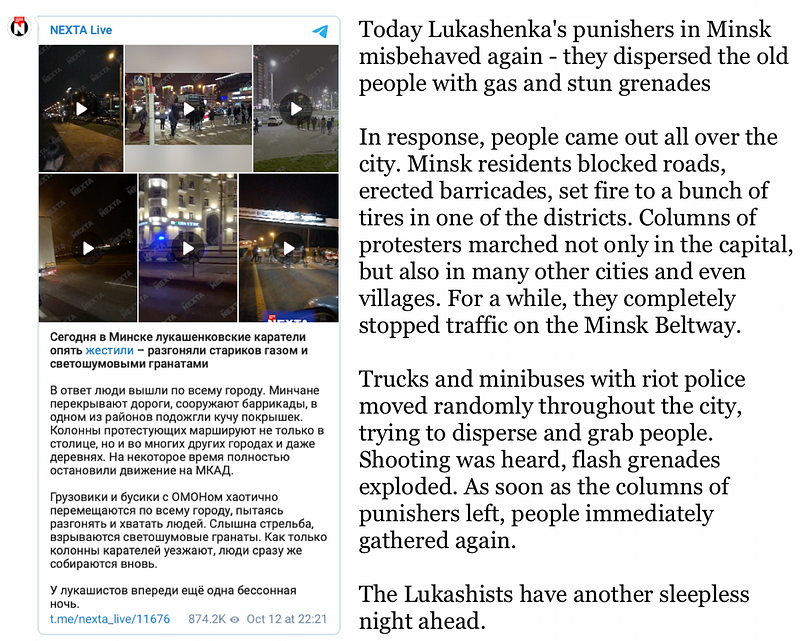
Another piece of alleged evidence of protester violence amplified on pro-Lukashenka Telegram channels was a damaged police minibus.
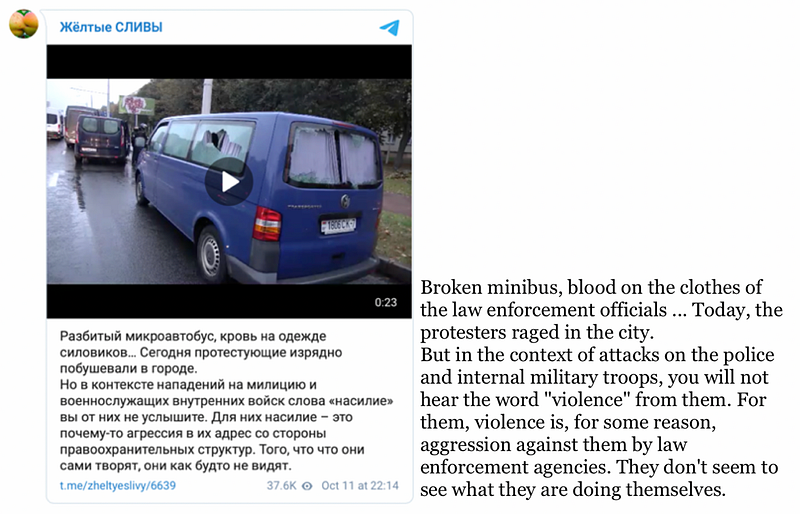
NEXTA Live, as well as the pro-Lukashenka Telegram channel Zheltye Slivy, published the video showing how protesters damaged the minibus, though the accompanying text of the videos was radically different. The pro-Lukashenka channel portrayed the footage as an act of violence by reckless kids, while anti-Lukashenka channel justified protester violence as “it is the only language the criminals understand.”
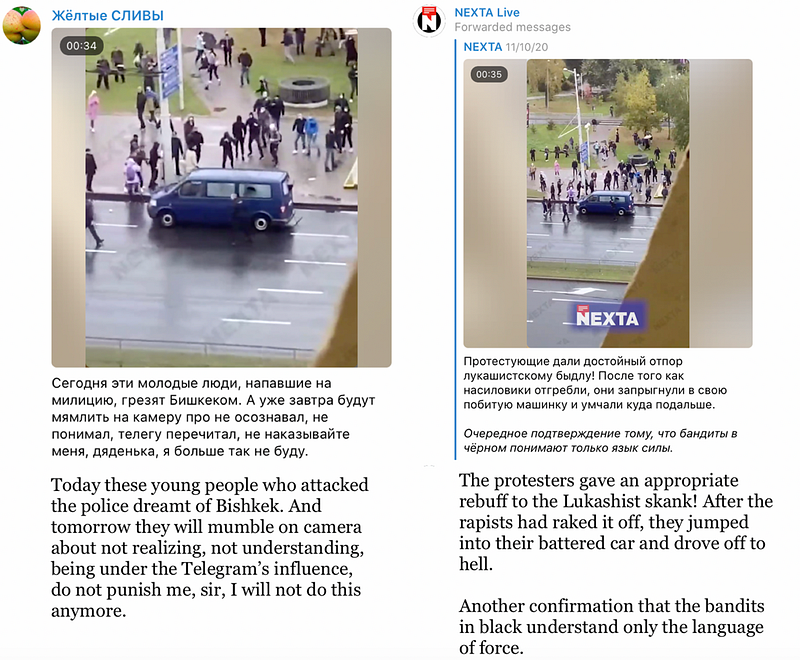
Police brutality
While some anti-Lukashenka protesters acted violently, Belarusian law enforcement authorities demonstrated disproportionate use of force against the protesters. The MoI announced that 713 protesters were detained; human rights NGO Viasna published a list of 616 people in detention.
In a video filmed by a correspondent of opposition outlet Nasha Niva showed how internal military troops pointed a rifle at a passerby and detained him.
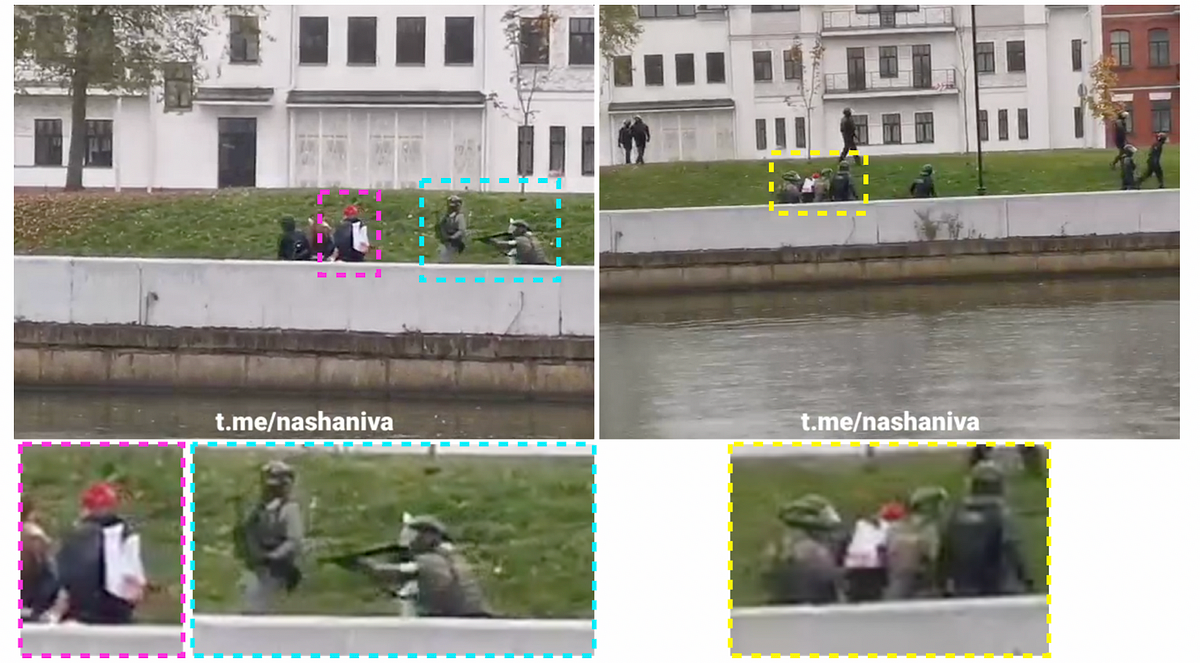
Multiple witnesses, meanwhile, captured the violent detention of Nikta Domrachev, a brother of an award-winning Belarusian biathlete, Darya Domracheva.
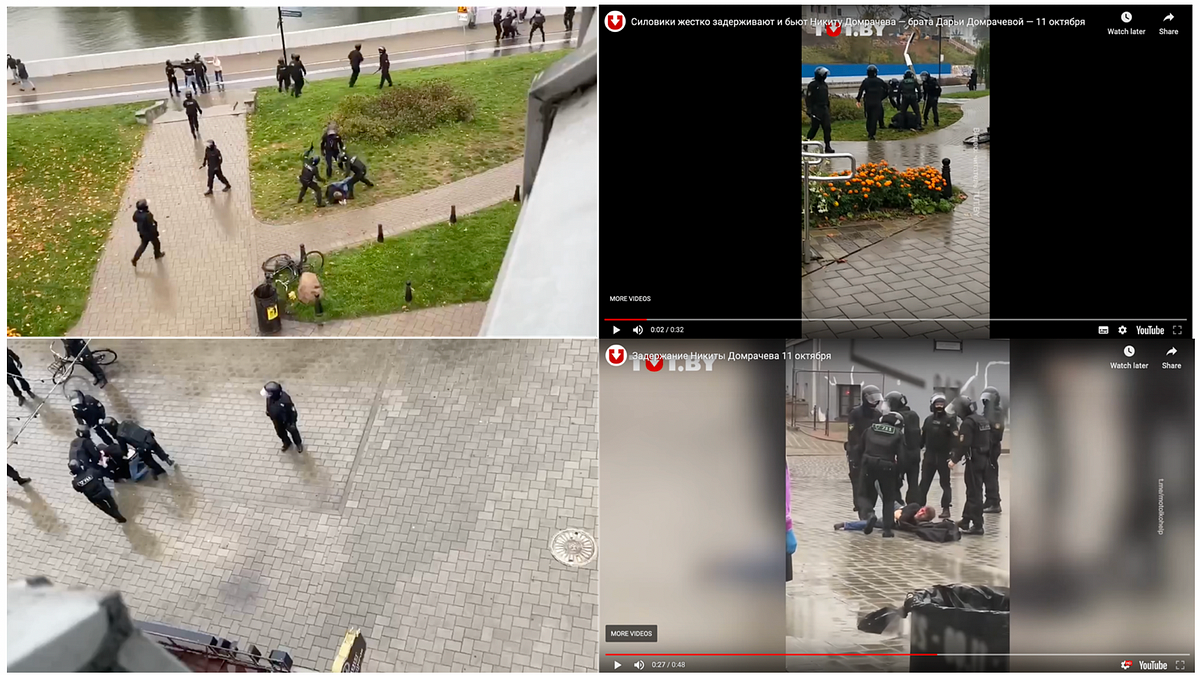
Judging from Domrachev’s own testimony to the independent outlet TUT.by, the OMON officers did not know who he was. He told the outlet that he was riding a bike when suddenly he saw men in olive-colored cloths screaming and running at him. He then turned off the cycling lane, where there were men in black. They pushed him off the bicycle and started to beat him without hesitation, though this part of his story is not visible on that particular video. On October 13, a girl who saw the detention and filmed the beating corroborated Domrachev’s statement that OMON pushed him off the bicycle and started to beat him.
Both testimonies stated that Domrachev’s head was bleeding, and OMON did not call for a medical assistance until Domrachev was brought into the police station.
The OMON officers interrupted the girl while she filmed the beating from a “metal container house where trash bins are stored.” Another video that was first published on a Telegram channel @motolkohelp shows how OMON officers were detaining the people who were in the container house. A Google Street view map of the location matches the buildings where the detentions reportedly took place.
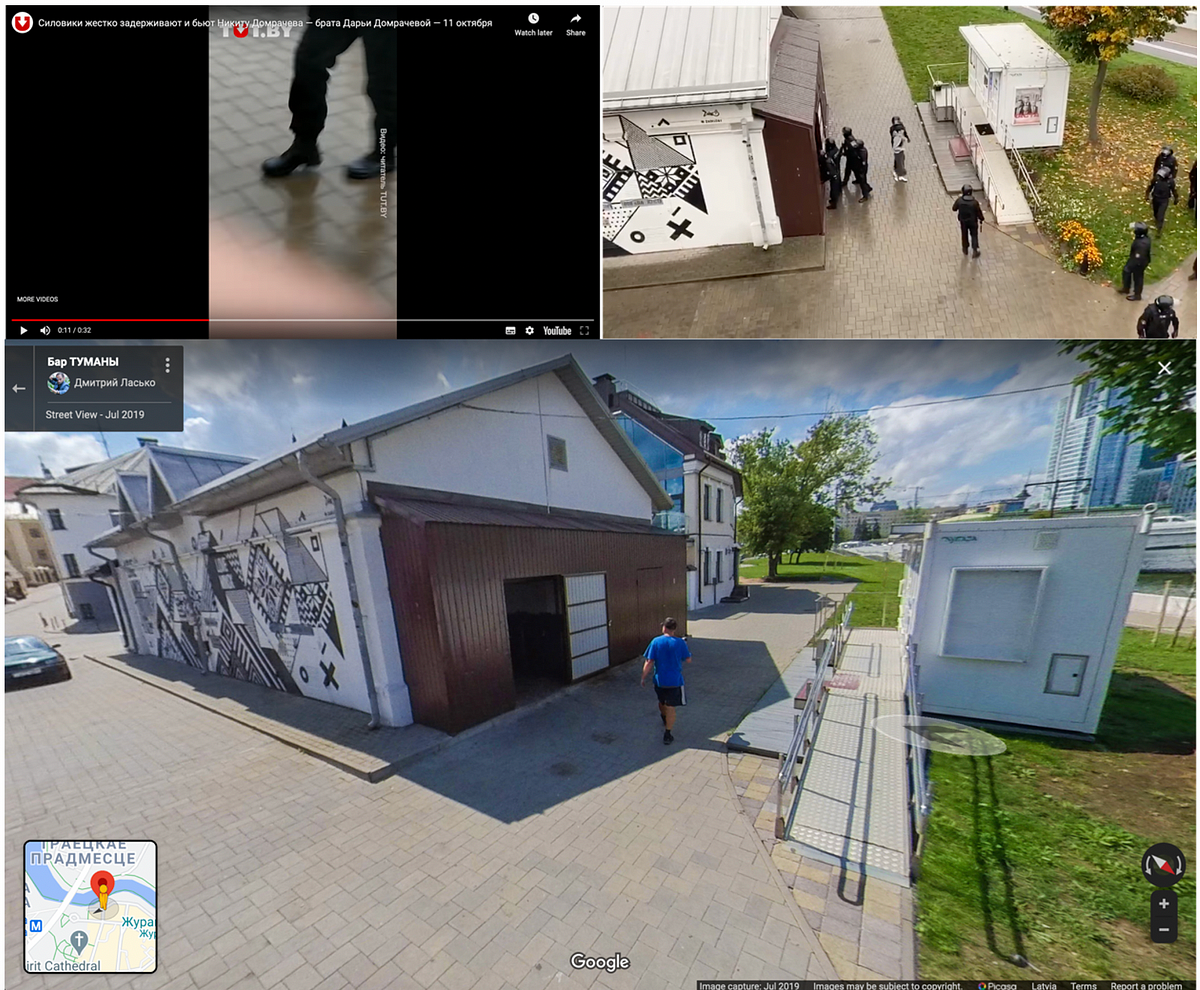
Other testimonies of disproportionate beating appeared the day following the protest. TUT.by compiled a video with victims’ testimonies. All of them had visible signs of beatings.
Meanwhile, Anti-Lukashenka Telegram channels reported on the use of flash grenades and tear gas to disperse protesters who gathered by the Minsk’s Hero City Square. The DFRLab geolocated the tear gas incident via a video from Euroradio, an independent Belarus media outlet.
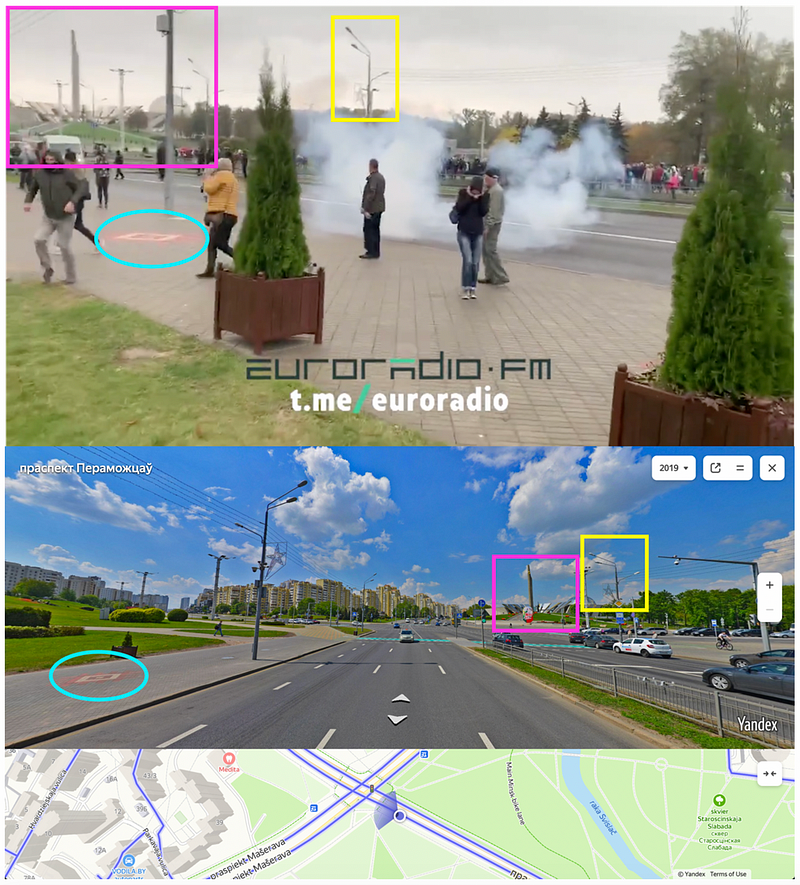
The use of flash grenades was included in the MoI video to portray protesters violence. A geolocation of a video frame shows that it happened next to the Minsk-Hero City square as well.
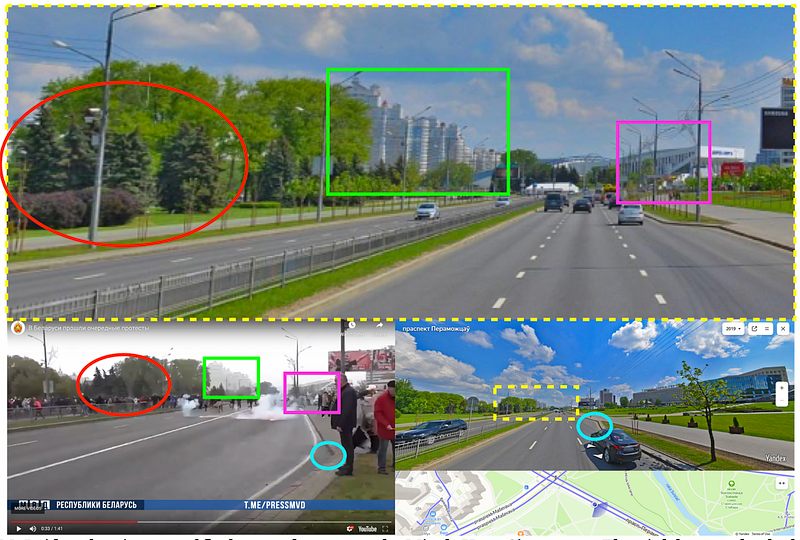
Other reports showed law enforcement using water cannons. The cannons sprayed an orange liquid used to mark people who were at the protests.
https://twitter.com/tutby/status/1315272894025433093?s=20
The increased police brutality and signs of protester violence signal a worrying escalation. Neither side of the conflict has expressed any readiness to give up.
Nika Aleksejeva is a Research Associate, Baltics, with the Digital Forensic Research Lab.
Follow along for more in-depth analysis from our #DigitalSherlocks.

